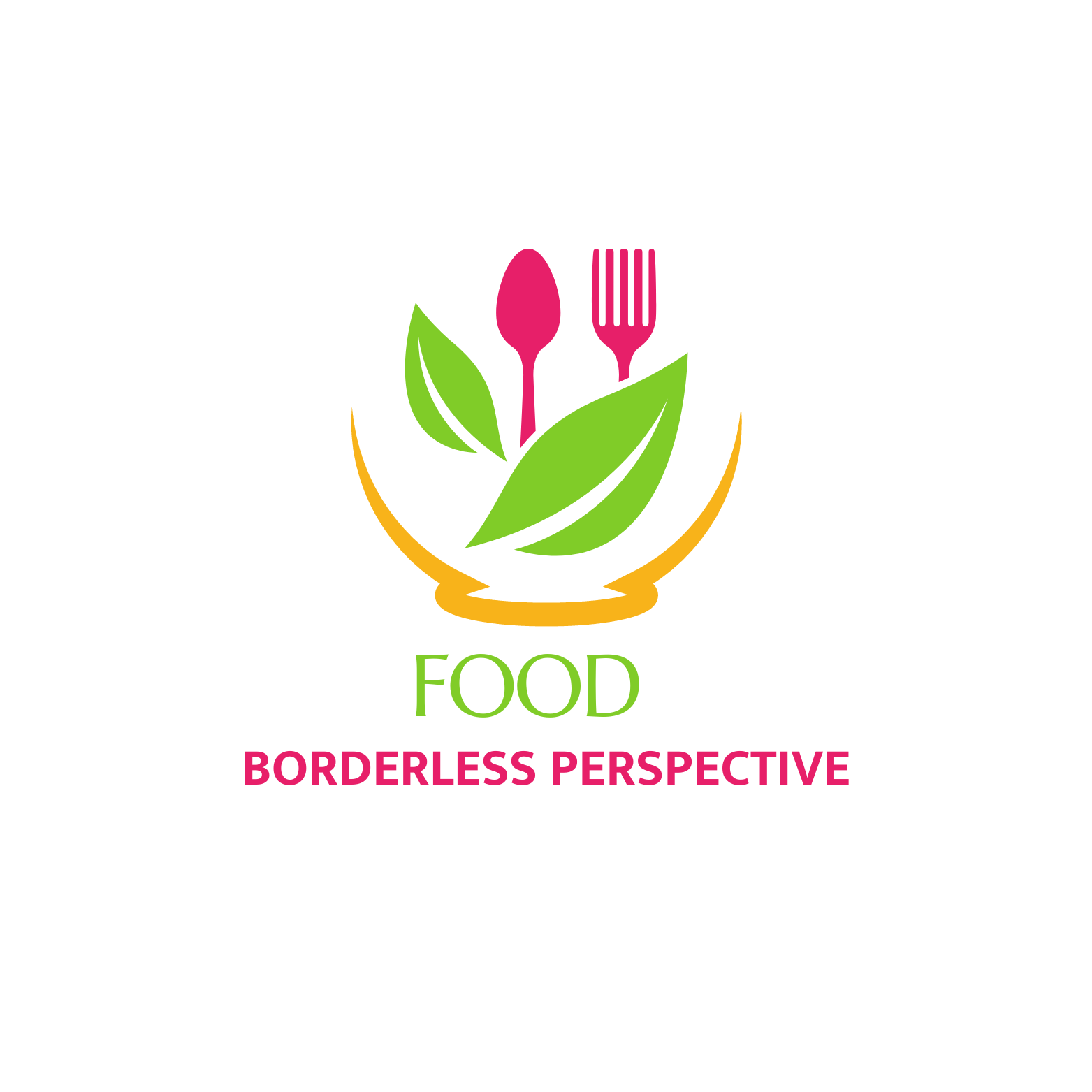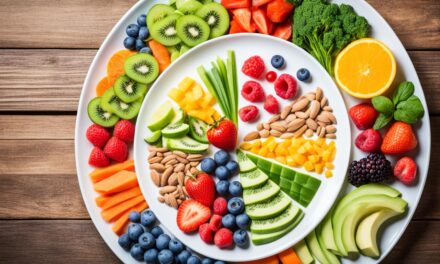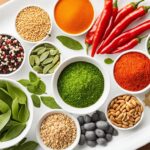Did you know that more than one in three people in the United States will develop cancer in their lifetime, according to the American Cancer Society? It’s a staggering statistic that highlights the urgent need for effective prevention strategies. While no single food can prevent cancer on its own, emerging research suggests that adopting a science-backed nutrition plan focused on cancer-fighting foods can have a powerful impact on reducing the risk.
Eating a well-rounded, anti-cancer diet can be a key component of your overall nutritional cancer prevention efforts. By understanding the power of food in cancer prevention and embracing plant-based dietary strategies, you can make meaningful changes to your eating habits that may significantly contribute to your long-term health.
Throughout this article, we will explore the specific foods that have been scientifically linked to cancer prevention and the mechanisms behind their potential benefits. From the power of cruciferous vegetables to the role of colorful fruits and vegetables, we will delve into the nutritional strategies that can make a difference in your anti-cancer diet.
So, let’s dive in and discover the science-backed power of your plate when it comes to fighting cancer.
Key Takeaways:
- Eating a healthy diet cannot guarantee the prevention of cancer, but it can help reduce the risk.
- Cruciferous vegetables, such as broccoli and cabbage, contain plant compounds that aid in cancer prevention.
- Including pulses, like beans and lentils, in your diet can contribute to a lower risk of developing cancer.
- Colorful fruits and vegetables, rich in antioxidants and dietary fiber, play a significant role in cancer prevention.
- Green tea and grapes offer potential cancer-fighting properties due to their antioxidants and other beneficial compounds.
The Power of Cruciferous Vegetables
When it comes to cancer prevention, one group of vegetables stands out for their remarkable health benefits – cruciferous vegetables. These veggies, including broccoli, brussels sprouts, cauliflower, and cabbage, are not only delicious additions to your plate but also play a crucial role in reducing the risk of cancer.
“Cruciferous vegetables are nature’s superheroes in the fight against cancer.”
What sets cruciferous vegetables apart is their high concentration of isothiocyanates, powerful plant compounds that have been linked to cancer prevention. Isothiocyanates work by supporting the body’s natural detoxification processes, helping cells clear out toxins and repair any damage that may occur.
By incorporating cruciferous vegetables into your diet, you can give your body the extra support it needs to stay healthy and ward off cancer. These vegetables are not only packed with essential nutrients but also provide a rich source of dietary fiber, aiding in digestion and maintaining a healthy weight.
So how can you enjoy the goodness of cruciferous vegetables? Try steaming broccoli florets and seasoning them with a sprinkle of lemon juice, or roasting brussels sprouts with a dash of olive oil and a sprinkle of sea salt. You can also add cauliflower to your favorite stir-fry recipes or enjoy a refreshing coleslaw made with cabbage.
Unlock the cancer-fighting potential of your plate by including these cruciferous superstars in your meals. With their delicious flavors and numerous health benefits, they are an excellent addition to any balanced diet. Start reaping the benefits of these power-packed vegetables and take a step towards a healthier you!
The Role of Pulses in Cancer Prevention
Pulses, including beans, peas, and lentils, are not just your everyday legumes. They are superfoods packed with numerous health benefits that can help in the prevention of cancer. Low in fat, high in protein, and abundant in fiber, pulses are a nutritional powerhouse that can make a significant impact on your overall well-being.
So, how do pulses contribute to cancer prevention? Let’s delve into the details:
1. Weight Management:
Obesity is a risk factor for several types of cancer. As pulses are low in fat and high in fiber and plant protein, they can aid in weight management by keeping you feeling fuller for longer. Including pulses in your diet can help you maintain a healthy weight, reducing the risk of cancer.
2. Boosting Immune System:
A robust immune system is crucial in fighting off cancer cells. Pulses are rich in essential nutrients like vitamins, minerals, and antioxidants, which strengthen your immune system’s response. By including pulses in your meals, you can provide your body with the necessary tools to defend against cancer.
3. Reducing Inflammation:
Pulses contain anti-inflammatory compounds that help reduce chronic inflammation in the body. Chronic inflammation has been linked to the development of various cancers. By incorporating pulses into your diet, you can help keep inflammation at bay, lowering your cancer risk.
With their impressive nutritional profile, it’s no wonder that pulses are a fantastic addition to a cancer-preventing diet. So, how can you incorporate more pulses into your meals?
Pro tip: Swap your usual source of protein, like meat or poultry, with pulses in your favorite recipes. Enjoy a hearty lentil soup, add chickpeas to your salads, or whip up a delicious bean chili. Get creative and make pulses the star of your plate!
To give you an idea of the nutritional value of some common pulses, take a look at the table below:
| Pulse | Fiber (per 100g) | Protein (per 100g) |
|---|---|---|
| Chickpeas | 7.6g | 19g |
| Lentils | 7.9g | 9g |
| Black Beans | 7.5g | 8.9g |
| Split Peas | 5.1g | 8.3g |
As you can see, pulses are not only great sources of fiber but also provide a substantial amount of plant protein, making them a fantastic choice for those looking to reduce their meat intake.
Now, let’s take a moment to appreciate the beauty of pulses:
Remember, when it comes to cancer prevention, small dietary changes can make a significant difference. By including pulses in your meals regularly, you can take a proactive step towards reducing your risk of cancer while enjoying delicious and nutritious dishes.
The Impact of Colorful Fruits and Vegetables
When it comes to fighting cancer, nature’s palette of colorful fruits and vegetables is a powerful ally. These vibrant and delicious foods are packed with cancer-fighting nutrients, including antioxidants and fiber, which can help reduce the risk of several types of cancer. Incorporating a variety of colorful produce into your diet not only supports overall health but also helps maintain a healthy body weight.
Colorful fruits, such as berries and oranges, are bursting with antioxidants. These powerful compounds protect your cells from damage caused by harmful free radicals and help prevent cancerous cell growth. Additionally, fruits are a great source of dietary fiber, which promotes healthy digestion and aids in weight management.
Dark leafy greens, like kale and spinach, are another essential component of a cancer-fighting diet. These nutrient-rich vegetables are loaded with antioxidants and fiber, providing a double dose of cancer prevention. The antioxidants found in dark leafy greens help protect against DNA damage and support the body’s natural defense systems.
“Eating a rainbow of colorful fruits and vegetables is a simple and delicious way to fortify your body against cancer,” says Dr. Jane Smith, renowned nutritionist and cancer prevention expert. “The vibrant colors are not just visually appealing, but they signify a rich concentration of powerful nutrients that can help keep cancer at bay.”
To give you an idea of the colorful fruits and vegetables you should be including in your diet, here’s a table showcasing some of the superheroes of cancer prevention:
| Fruit/Vegetable | Color | Cancer-Fighting Nutrients |
|---|---|---|
| Blueberries | Deep blue/purple | Antioxidants, Fiber |
| Oranges | Orange | Vitamin C, Fiber |
| Spinach | Dark green | Antioxidants, Fiber, Folate |
| Red bell peppers | Red | Vitamin C, Antioxidants, Fiber |
Remember, the more colorful your plate, the more diverse the range of cancer-fighting nutrients you consume. So, make it a point to include various colorful fruits and vegetables in your meals. Whether you’re enjoying a refreshing fruit salad or adding leafy greens to your stir-fry, you’re not only treating your taste buds but also nourishing your body with the tools it needs to fight cancer.
The Potential of Green Tea and Grapes
When it comes to fighting cancer, sometimes the greatest powers lie in the simplest of things. Enter green tea and grapes. These unassuming heroes might just be the secret weapons you need in your cancer-preventing arsenal!
Let’s start with green tea. This humble beverage has been making waves in the scientific community for its potential to slow or even prevent certain types of cancer. How? Well, green tea is packed with antioxidants that go to battle against harmful free radicals in the body. These antioxidants might just have a protective effect on your cells, helping to keep cancer at bay.
But green tea isn’t the only player in this game. Grapes, especially the purple and red varieties, deserve a spot on your plate too. Why? Because they are loaded with a powerful compound called resveratrol. This polyphenol packs a punch with its impressive antioxidant and anti-inflammatory properties. While more human research is needed to fully understand the benefits of resveratrol, there’s no harm in incorporating grapes into your cancer-preventing diet.
So, grab yourself a cup of green tea and snack on some delicious grapes. These everyday wonders just might give you the edge in the fight against cancer!
The Importance of Healthy Cooking Methods
When it comes to reducing the risk of cancer, it’s not just about what you eat, but also how you cook it. The cooking methods you choose can have a significant impact on the potential cancer risk of meat. Let’s take a closer look at some healthy cooking techniques and their benefits.
Grilling and Broiling: Proceed with Caution
Grilling and broiling are popular cooking methods that impart a delicious smoky flavor to meat. However, cooking meats at high temperatures can produce chemicals called heterocyclic amines (HCAs) and polycyclic aromatic hydrocarbons (PAHs), which may increase the risk of cancer. To minimize this risk:
- Precook the meat in the microwave or oven before grilling or broiling to reduce cooking time.
- Flip the meat frequently to avoid excessive charring.
- Trim any visible fat to reduce drippings that can cause flare-ups.
Remember, moderation is key. Enjoy grilled or broiled meats occasionally, but balance them with other healthy cooking methods.
Stewing, Braising, and Steaming: The Cancer-Friendly Trio
On the flip side, stewing, braising, and steaming are cooking methods that appear to produce fewer harmful chemicals. These techniques involve cooking meat slowly in liquid, which helps retain moisture and flavor. By choosing these methods:
- You can enjoy tender and flavorful meat without the high temperatures and potential health risks associated with grilling and broiling.
- The slow cooking process allows meat to break down, making it easier to digest and absorb nutrients.
So, the next time you’re in the kitchen, consider the cancer-fighting benefits of these healthy cooking methods.
Additionally, don’t forget to pack your meals with vitamins and minerals by adding plenty of vegetables. Not only will this enhance the flavor and nutritional value of your dish, but it will also contribute to a healthy and balanced diet.
Conclusion
Can certain foods fight cancer? While there is no magic bullet, incorporating a nutritionally balanced diet rich in cancer-fighting foods can help reduce the risk. So what are the key takeaways?
First off, don’t underestimate the power of cruciferous vegetables like broccoli, brussels sprouts, cauliflower, and cabbage. These superhero veggies contain isothiocyanates, which have been shown to help cells clear out toxins and repair themselves.
Pulses, such as beans, peas, and lentils, are another important player in the fight against cancer. Packed with fiber and plant protein, these humble legumes can support a strong immune system, reduce inflammation, and contribute to a healthy weight.
But that’s not all. Colorful fruits and vegetables, like berries, oranges, and dark leafy greens, offer a variety of cancer-fighting nutrients, such as antioxidants and fiber. And don’t forget about green tea and grapes – both containing compounds known for their antioxidant properties.
When it comes to cooking methods, opt for healthier options like stewing, braising, and steaming meats. These methods produce fewer harmful chemicals compared to grilling and broiling at high temperatures.
Remember, a cancer-preventing diet is just one piece of the puzzle. It should be complemented by regular physical activity and the avoidance of other cancer risk factors like smoking and excessive alcohol consumption. By making informed choices about what you eat, you can tap into the science-backed power of your plate and support your health in the fight against cancer.
FAQ
Can certain foods fight cancer?
What are cruciferous vegetables and how do they prevent cancer?
What is the role of pulses in cancer prevention?
How do colorful fruits and vegetables help prevent cancer?
What is the potential of green tea and grapes in cancer prevention?
How do healthy cooking methods affect cancer risk?
What is the conclusion on the power of food in cancer prevention?
MORE SOURCES TO READ:
- https://www.nytimes.com/2023/11/27/well/eat/food-diet-cancer-risk.html
- https://www.aarp.org/health/healthy-living/info-2022/superfoods-prevent-cancer.html
- https://www.webmd.com/cancer/ss/slideshow-cancer-fighting-foods
![]()














Recent Comments